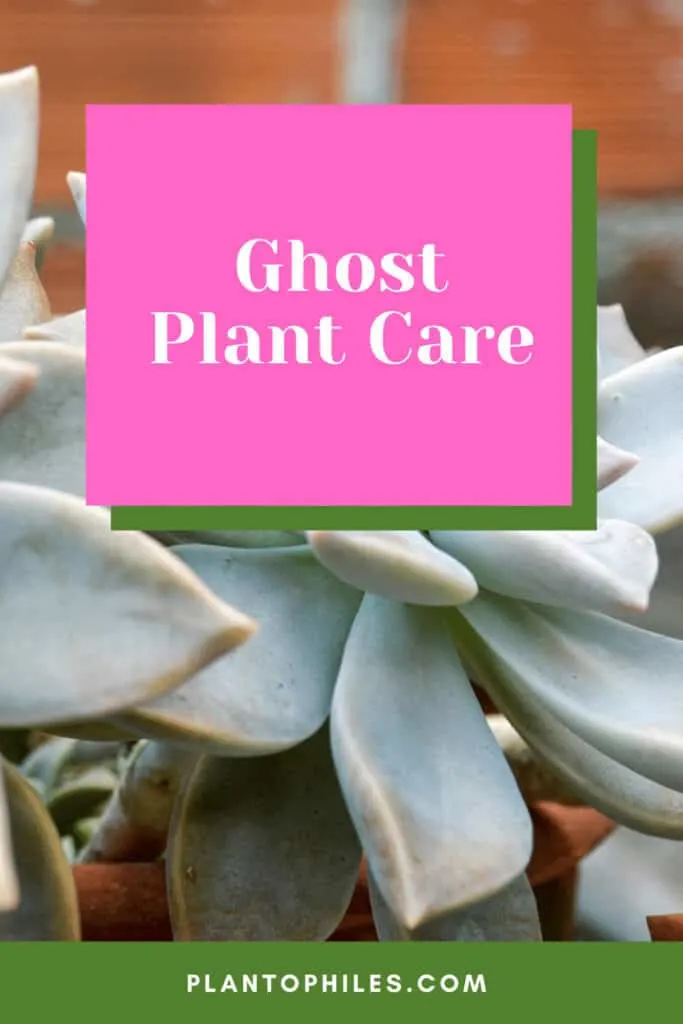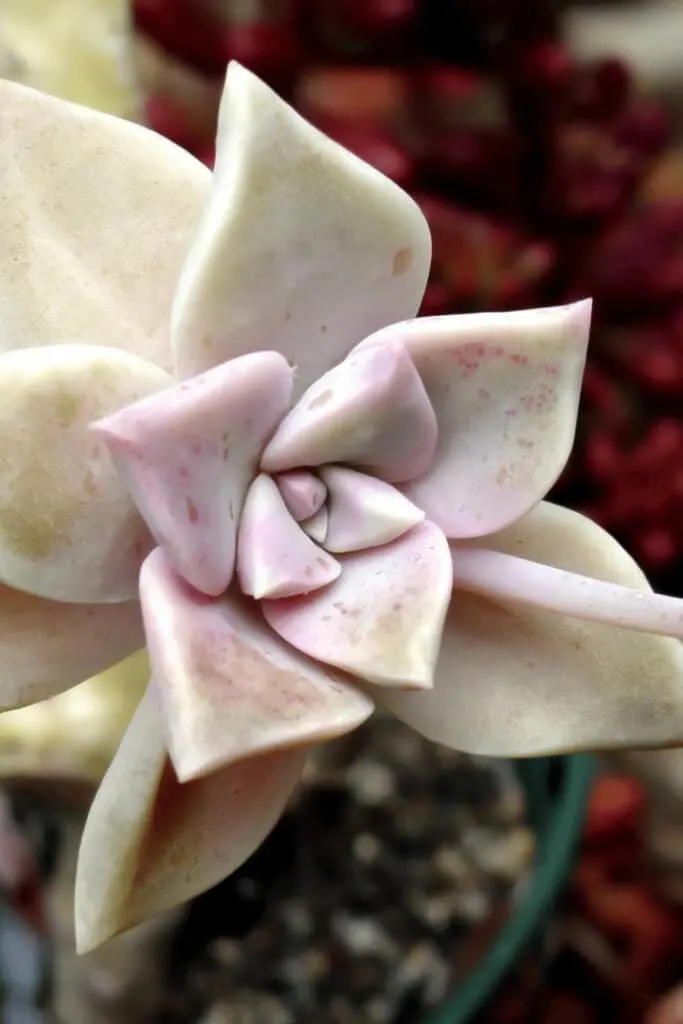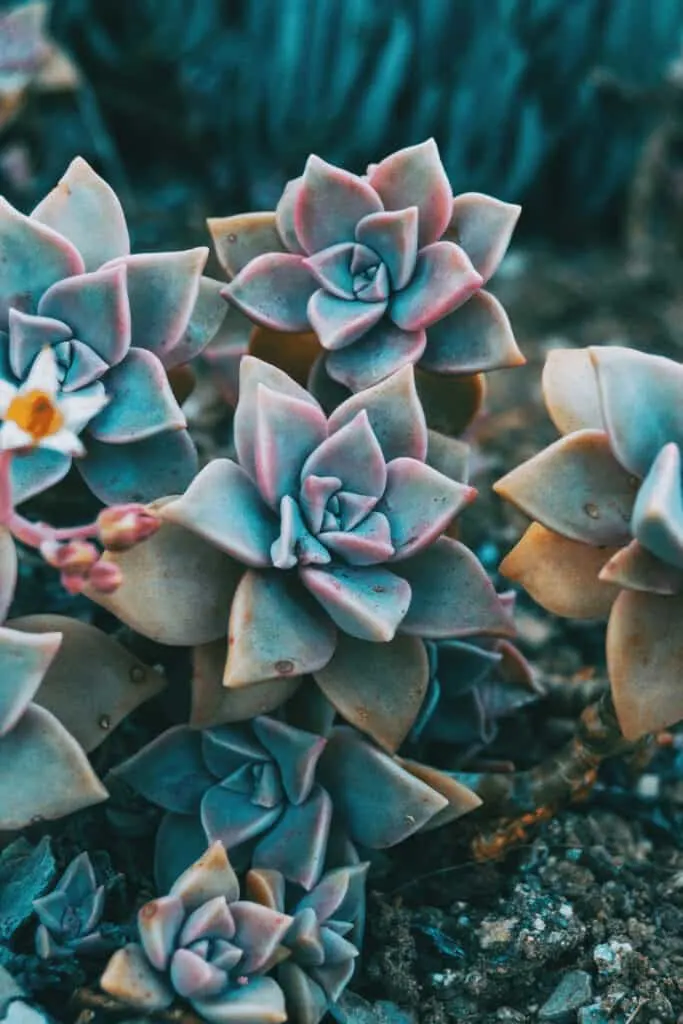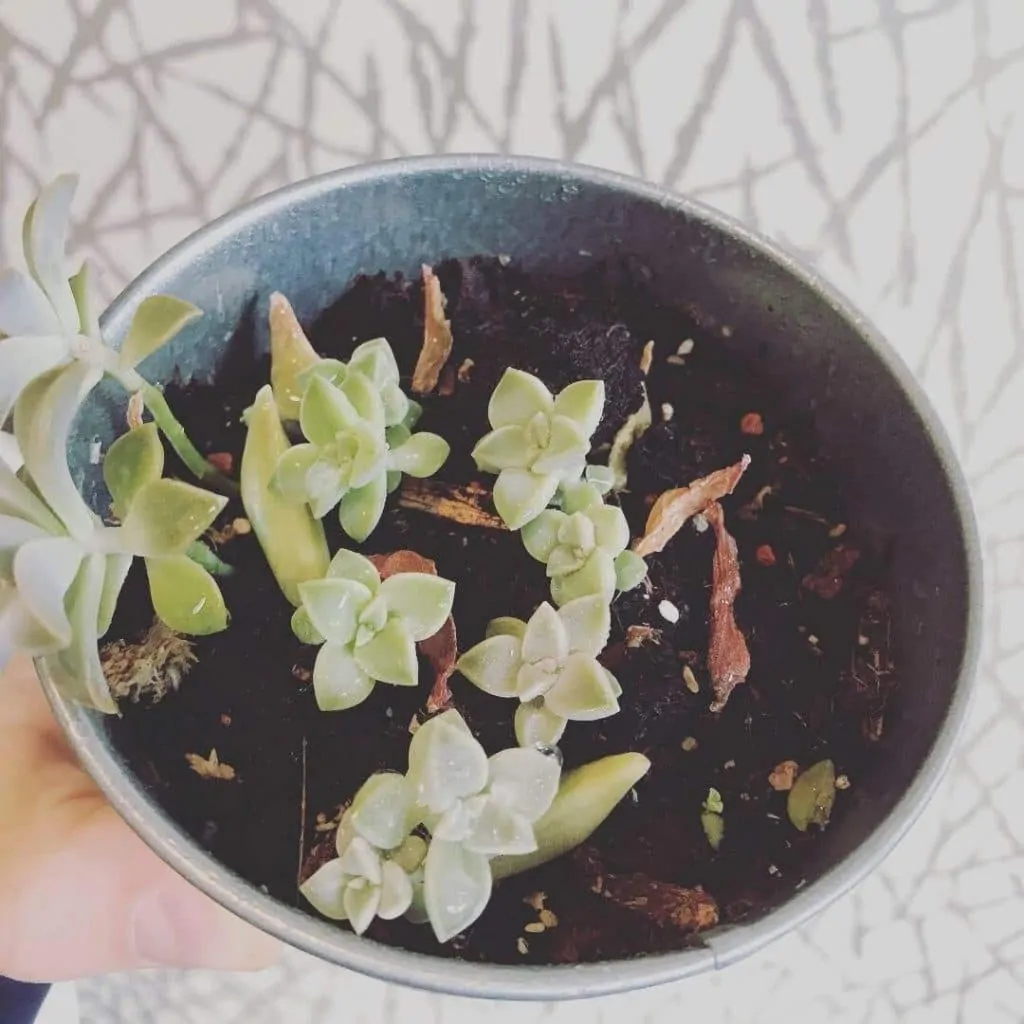Ghost Plant Care
To care for a Ghost plant water once the soil is dry to a depth of one inch. Provide a porous potting mix consisting of soil mixed with up to 50% sand, gravel, or perlite. Watering once every week in the growing season. The best temperature is between 60 – 80 °F (16-27°C). Keep humidity below 50%. Use a balanced succulent fertilizer at 1/2 strength once a month in the growing season.

Ghost Plant Care
Table of Contents
Ghost Plant Care Guide
The Graptopetalum paraguayense has increased in popularity as a houseplant as it is inexpensive, easy to grow, easy to propagate, and the flowers are displayed in a beautiful star formation.
Ghost plants are just amazing!
So let’s take a more in-depth look at exactly how to care for this plant.

Ghost Plant Care
Soil
The soil of the Ghost plant needs to be particularly well-draining using potting soil and 50% sand, gravel, or perlite.
A light, porous potting soil mixed with up to 50% sand, gravel, or perlite will provide your ghost plant with the ideal conditions to grow and avoid common problems associated with overwatering.
In the natural habitat, the soil where the plant grows is relatively nutrient-poor.
It’s more important to the plant that the soil drains well.

Ghost plants grow best using a porous potting mix
Light
The Ghost plant prefers to grow in full sun which promotes an almost translucent pink hue to the leaves.
However, the ghost plant will tolerate partial shade which will produce a blue, grey hue on the leaves.

Bright direct sunlight is best for these succulents
Watering
Water a Ghost plant once a week in spring and summer once the top 1-inch of soil is dry.
Watering is the most important factor when it comes to caring for ghost plants.
The plant should be watered once a week during the active growing season in spring and summer and only once every two or three weeks in the winter to avoid overwatering.
You should wait till the soil is dry to a depth of one inch before watering.
Water the soil directly around the base of the plant and avoid watering directly onto the leaves in the morning as they could scorch on a hot, sunny day.
Temperature
The ideal temperature for a Ghost plant lies between 60 – 80 °F (16-27°C).
As succulents are concerned, the ghost plant is fairly hardy when it comes to temperature range, and they will grow comfortably at room temperature in your home.
In their native Mexico, they thrive in hot, dry conditions but can tolerate low nightly temperatures in a mountainous environment.
Ghost plants can tolerate temperatures down to 10°F (-10 °C).

The ideal temperature for Graptopetalum paraguayense is 60 – 80 °F (16-27°C)
Humidity
The ideal humidity for a Ghost plant lies below 50%.
With ghost plants, it is best to avoid rooms in your house that get too humid or have a lot of moisture in the air, such as the bathroom or kitchen where there can be lots of steam.
The ghost plant prefers an arid environment and will be at home on a window in the sun.
Fertilizer
Fertilize a Ghost plant using a balanced liquid fertilizer at 1/2 strength once a month in the growing season.
As with indoor pot plants the soil may need a supplementary feed as the plant will eventually exhaust all the available nutrients in the pot.
The key is to feed the plant when it’s actively growing in the spring and summer to ensure a healthy plant.
I personally use a balanced succulent fertilizer at half strength in the growing season in spring and summer and apply it once a month.
Propagation
The easiest way to propagate a Ghost plant is through leaf propagation.
The Propagation of ghost plants is very easy as the plants essentially reproduce this way in their natural environment.
The stems of the ghost plant are actually rather brittle and any rosette that breaks away will root and start its own plant.
This plant is so keen to colonize that even leaves that are cut off will root and form a new plant.
It is essential that the wound where the plant is cut has time to dry out and callous over before being planted and watered.

Ghost plants are very easy to propagate by using leaf “cuttings”
Growth
The Ghost plant is not a big grower because it is naturally a desert-dwelling plant.
If it’s given enough space and potted to allow for more growth and has the optimal growing conditions, the plant can reach 12′ tall (30 cm) and trail 3 feet (91cm). You can me cuttings regularly to propagate for more plants.
Potting
Repot a Ghost plant in spring once it is outgrowing its pot.
With Graptopetalum paraguayense, you shouldn’t have to repot often.
However, if the plant has outgrown the pot, you should move the plant to a bigger pot in the spring.
This is also a good time to cut back the older growth and start propagating.
What does the Ghost Plant Look Like?
The Natural habitat of Graptopetalum paraguayense is in the mountainous, arid climate of Tamaulipas in the North-East of Mexico.
Ghost plants are characterized by their thick fleshy leaves that form beautiful rosettes that store water.
This is a trait shared by all succulents as an adaptation to arid environments.
The color of the leaves can range from pale green to an attractive pale blue hue.
The plant’s leaves grow in trailing rosettes which are around four inches (10 cm) wide.
Ghost plants occasionally flower in spring and summer with small white and yellow flowers.
Propagation of the Ghost Plant
The ghost plant is great for beginners as there is a high chance of success if you are inexperienced with propagation.
Propagation is essentially how the plant reproduces in the mountainous, arid terrain of Mexico, so the ghost plant doesn’t require lots of specialized knowledge or experience to successfully propagate a new plant.
It is best practice to propagate ghost plants during the growing season (spring and summer) as they will root quicker this time of year and have a better chance of survival than in the winter months.
You can propagate with:
• Cuttings from a stem from older or excessive growth or…
• From just an individual leaf from the stem or one of the rosettes
The easiest way to propagate with the best chance of success is to cut off one of the bigger stems from the main plant which will give new growth that’s underneath the space, light, and opportunity to thrive.
Use a sharp, sterile knife or pair of scissors for a clean cut. Cut the stem that you want to propagate and remove any of the lower leaves that grow off the stem, so you just have the rosette of leaves left at the top of your cutting.
It is this part of the plant that has the best chance of propagating.
The next bit is counter-intuitive and contrary to how you would propagate any other plants outside the succulent family.
You need to let the wound from your cutting dry and allow it to callous over.
This allows for the plant to retain all the water that it stores in the thick waxy leaves.
Storing water in the stems and leaves rather than relying on a consistent supply of water in the soil is an adaptation to arid climates that is unique to the succulent family of plants.
If you do not give the cutting the opportunity to callous over the plant will rot when you come to plant and water it.
You can either let the cuttings dry out for two days on a window sill or arrange the cuttings in a pot of soil that is bone dry.
I must reemphasize it is crucial to allow all the wounds from your cutting to dry out first for two days before you water the plant.
I know as a gardener this can go against all your instincts!
To be on the safe side, after two or three days, physically check to see if all the wounds have been calloused over and are dry to the touch.
Once you are satisfied the wounds are all dry, arrange your cuttings in a pot of well-draining soil with some additional sand, grit, or perlite.
If you are planting multiple cuttings in one pot allow about three inches between each plant.
It is at this point you can give the plant a generous watering; making sure the soil is nice and moist.
Leave it a week before watering again. This new cutting will form roots, and you will have a happy new ghost plant!
Propagate Ghost Plants from Leaf
Propagation from the leaves of your ghost plant is another great way to make the most of your plant.
The ghost plant will shed leaves and naturally propagate in this way if it is in a big enough pot with enough exposed soil and if it’s given the opportunity.
To propagate the leaves of the Ghost plant, you need to very carefully twist the leaf off from the main stem with as clean a break as possible.
This may take a bit of practice to get right to start with the leaves that are lower down on one of the main stems.
Then, much like the stem cuttings, you need to place the leaves on the dry surface on the window sill in the sun for at least 24 hours. This gives the wound a chance to dry and callous over.
After the wound is completely dry, you can place each cutting straight onto the soil in your pot and give them about an inch apart from each other. It really is that simple.
Now you can give your leaves a good drink.
This will stimulate the leaf to develop roots and grow into a new plant.
However, you should still follow the principle of ‘soak and dry’ where you give the plant a generous watering once a week and then leave it till the soil is completely dry before you next water.
Every leaf can be different and grow at different rates, but roots can appear a week or so after the cutting.
When the roots first appear from the leaf, it’s a good idea to move the pot to an area of the partial sun.
A relentless blazing sun in hot climates can damage the new roots.
If you see roots growing there is a good chance a new rosette should form and you will have a brand new ghost plant after a few weeks!
The parent leaf will eventually wither away at which point you can remove it, and your brand new plant should be rooted into the soil.
I would recommend that you try this with several leaves at one time as the chances of successful propagation from individual leaves are lower than from stem cuttings.
This is how the ghost plant spreads in its natural environment, so propagation is a lot easier with this succulent than most other plants, so if you are a propagation novice, this is a great place to start.

Propagated Ghost Plants from leaves. The dried-up bits on the soil were leaves where new plans started to grow. The success rate was close to 100%.
4 Tips to Keep your Ghost Plant in Great Shape
#Tip Number 1
Ghost plants love the full sun so pick a nice sunny window sill or spot in your greenhouse to make sure your succulent is as happy as can be.
#Tip Number 2
When it comes to soil, ghost plants are hardy (they naturally grow in nutrient-poor sandy soils), so you can use a general-purpose potting soil, but you must amend it with around 50% sand, grit, or perlite to make sure the structure of the soil remains porous so the water can permeate effectively.
#Tip Number 3
Ghost plants thrive off a cycle of soak and dry. Watering about once a week in abundance gives the plant the opportunity to draw the water up for storage in their leaves and stems.
If you are unsure whether your succulent needs watering, test how dry the surrounding soil is with your finger to a depth of 1 inch.
If you detect any moisture at all, then you can leave watering for another day or so. If the soil is bone dry, then this is the perfect time to water to keep the plant healthy.
#Tip Number 4
Try not to move your ghost plant too frequently to rooms that have different temperatures and conditions.
The plant adapts well to the temperature, humidity, and level of sunlight of a particular location so if it is constantly moved it will constantly have to adapt to new surroundings.
3 Things you shouldn’t do to your Ghost Plant
1. The plant has brittle stems so moving the plant around frequently can cause the stems to break off and potentially damage the plant so try to handle it with care when you are moving or repotting.
2. A classic mistake with the Ghost plant (and all succulents) is to overwater the pot.
Remember this plant is happy in the desert and has specially adapted to enjoy being watered once a week in the growing season and once every two or three weeks in the colder months.
3. Do not plant in a pot without drainage holes in the bottom.
Ghost plants are particularly susceptible to root rot so you need to make sure your pot has a drainage hole in the bottom so excess water can escape otherwise the water will sit there and eventually kill the plant.
Frequently Asked Questions about Ghost Plants
How often do I need to water a Ghost plant?
Water once a week in the growing seasons in spring and summer. Water about once every 2-3 weeks in autumn and winter. You only need to water if the potting mix is dry once an inch into the soil.
How do I propagate a Ghost plant?
Ghost plants are very easy to propagate. You can take stem cuttings and lay them on slightly humid soil. Within 2-3 weeks, new growth will start.
Is the Ghost plant toxic?
The Ghost plant is benign, and no part of the plant is toxic or poisonous to either humans or animals, even if you consume them. Ghost plants are a very safe plant to have around children and pets and are completely harmless.
Where does the Ghost plant come from?
The ghost plant is a native of North-Eastern Mexico where they thrive in arid, isolated mountain habitats near the Chihuahuan Desert in poor quality, sandy soils. They are perfectly adapted to this harsh, drought-prone environment by storing water in their thick fleshly leaves and stems and only drawing upon it when it needs to.

Daniel has been a plant enthusiast for over 20 years. He owns hundreds of houseplants and prepares for the chili growing seasons yearly with great anticipation. His favorite plants are plant species in the Araceae family, such as Monstera, Philodendron, and Anthurium. He also loves gardening and is growing hot peppers, tomatoes, and many more vegetables.


